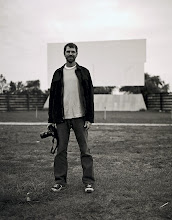

I thought I'd post a lighting scheme from a recent architectural interior that I shot for a print ad. Although I used tungsten lighting on this particular job, I also use strobes or natural light depending on how the interior "speaks" to me. I always let the feel of an interior determine the type of lighting I use. Because of the white theme of this kitchen, I felt the need for tungsten lighting because of it's high degree of controllability and also for the drama that tungsten lighting can create in what would otherwise be a very flat looking photograph because of the all white theme. I used three types of lights in this shot-Lowel VIP Pro 250w lights, Arri Compact 125w lights and Calumet 650w lights (which are no longer in production). All lights are equipped with barn doors.
Light #1 is a Calumet 650 in the far end of the scene bounced into a white scrim taped to the hallway wall to light the door area. I always use a pure white scrim when bouncing lights because if you don't, your light will take on the hue of whatever color of wall you're bouncing into. On this light and most of the others, I also used "black wrap" a matte black foil that you can buy from well stocked camera stores to drape over the lighting housing to prevent any stray light leaks. Black wrap is also great for using as a gobo attached to the barn doors themselves as another way to get the most control over the light source. Light #2 is an Arri 125 on a short floor stand aimed at the cabinets on the far left hand wall. When this light was first placed, the glare on the cabinets was overpowering. It's an easy fix, though-Just screw on a polarizer and you eliminate the glare. Light #3 is a Lowel 250 on a stand just behind the wall that separates the cabinet wall from the range counter. One leg of the stand had to be Photoshopped out because of the extremely small area in which to place the light. It is aimed to hit a couple places-The glass cabinet containing white serving bowls to the left of the back window and also the shelves on the right side of the same window. Lights #4 & #5 are Lowel 250's on small floor stands aimed down the cabinets on either side of the middle island. Light #6 is an Arri aimed at the end of the island facing the camera and Light #7 is a Calumet aimed at the bowl of nuts and also hitting the cabinets on the right side of the frame. Light #8, another Calumet, is in the family room on the other side of the pass through and is aimed at the cabinets under the back sink. Light #9 is a Calumet and is aimed at he glass paned doors in the family room and Calumet light #10 is aimed toward the sink in the island in order to highlight both the sink fixtures and plates. Besides barn doors and black wrap, I also used neutral density gels when needed and wooden clothespins clipped to the barn doors and used as small gobos. Post production was pretty straight forward-The only real change to the image was to clone the vine outside the window to cover more area.
















